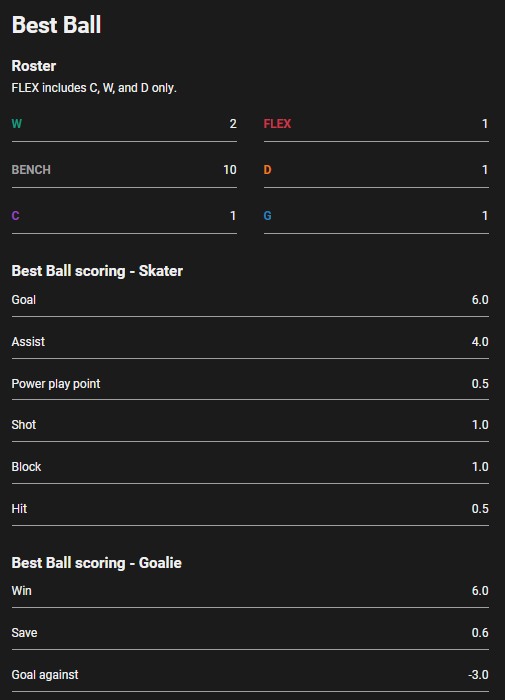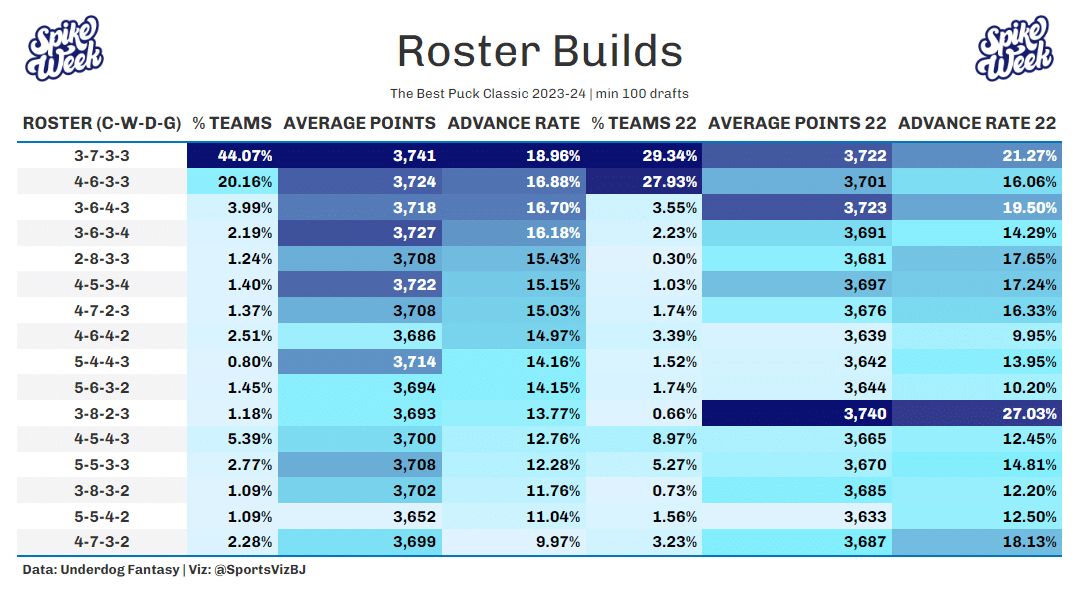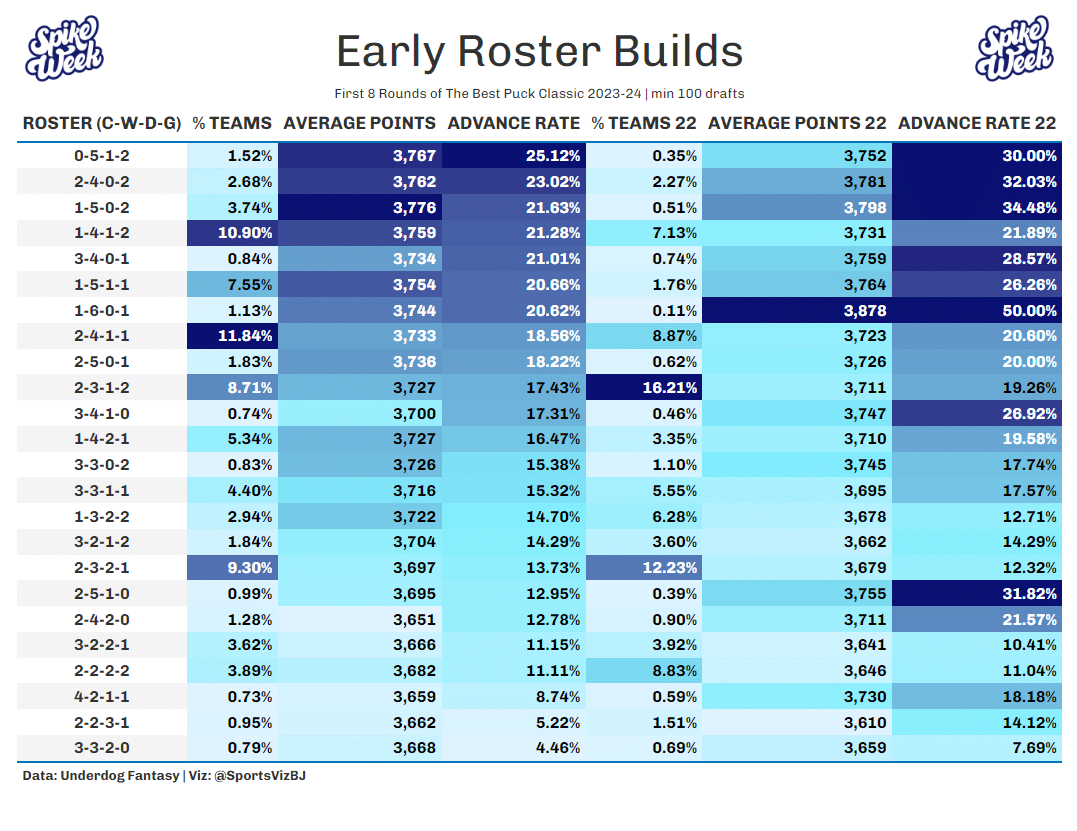Introduction
What’s up Spike Week fam? I am back with another data driven review of prior season tournaments on Underdog to help you find an edge in this year’s tournament. We are in the heat of the NFL Best Ball Summer but one of my favorite contests to play is the hockey best ball contest that Underdog offers called the Best Puck Classic. I flirted with the tournament last year but am ready to fully lean in and take down the Best Puck Classic crown using the data insights shown below.
Tournament Basics
In the Best Puck Classic, rosters consist of 16 players. In each week, teams must field 1 Center, 2 Wingers, 1 Defenseman, 1 Goalie, and 1 non-goalie Flex. Scoring for skaters is comprised of both offensive (goals, assists, shots, and power play points) and defensive (hits and blocks) individual statistics while goalies on the other hand are directly impacted by the play style and quality of the team around them, as their scoring is based upon wins, saves, and goals against; which a goalie has only so much control over.

Scoring and Advance Rate Shapes
To determine what the field has been doing and what has worked, we are going to look at the last two Best Puck Classics. The tournament has grown from 2,352 entrants in 2021-22, to 5,640 entrants in 2022-23, and 14,100 entrants last year. I am going to focus on the last two years due to the increased sample size and more informed draft market in these contests.
To kick off the analysis let’s start with a basic, ADP x Best Ball Scoring to see how positions score and maybe visualize some tiers.


Analysis:
- Centers: Centers are going to outproduce other positions at almost every point in the draft.
- Wingers: Production has steadily declined throughout the draft, especially as the market priced up the position in 2023-24.
- Defensemen: Production has been quite flat, with a notable dead zone in the middle rounds where production is often matched or outmatched by later picks.
- Goalies: Goalie production is as flat as defensemen, if not flatter, but drops off significantly in the late rounds.
Next, I wanted to peek at advance rate shapes for the positions. Note in the 2022-23 tournament the advancement structure was 3 out of 12 but I calculated the theoretical 2 out of 12 structure that we saw in 2023-24 and see the current year contest.

 Analysis:
Analysis:
- Wingers: Mid-round wingers have been key to success year over year.
- Defensemen: Late-round defensemen have been great picks in both tournaments.
- Centers: There appears to be a “bad zone” to avoid in the middle rounds rather than a section that must be targeted.
- Goalies: Goalie advance rate shapes have been inconsistent in each of the two years.
Team Structure
Team structure is essential when drafting any best ball team to ensure the team isn’t completely toast upon ending the draft. Here, we identify basic guidelines to keep our teams on track so we can capitalize on drafting the right players.
 Analysis:
Analysis:
- In the 22-23 contest, the best advance rates were two and three center teams, even though the field’s most common build was four center teams.
- In the following year, the field reacted to the prior year data and three center teams dominated the field’s builds and performed the best, yet not as dominant as the year prior.

Analysis:
- In the 22-23 contest, the field most commonly built six and seven winger teams and the seven winger teams dominated.
- Again, in the following year, drafters chased the prior year optimal as seven winger teams became the clear most common build and just like the center position, the edge gained from drafting seven wingers was reduced from the year before.

Analysis:
- In both tournaments, the field has been extremely concentrated with their defensemen builds, with over 70% of teams building this way in both years. Teams that drafted three defensemen had an above average advance rate and teams that did not were quite disastrous.

Analysis:
- Copy + paste defensemen section but replace defensemen with goalie.

Analysis:
- Combine all the above, the most common and successful build for the past two years has been the balanced 3-7-3-3. Additionally, there is some evidence that builds a single deviation off the basic 3-7-3-3 can have utility when designed correctly, yet the field has consolidated heavily around 3-7-3-3.
Takeaway: Don’t get too weird. Stick to the balance build of 3-7-3-3 and allow for a deviation or two at most depending on where your draft took you. Rosters like 4-6-3-3, 3-6-4-3, 3-8-2-3, etc. are more than viable when leaning into elite/punt center or defensemen builds so don’t feel like you are stuck in a box. Just don’t be a dunce about it.
Early Round Structure
The problem with summary data is it’s muddied with people who took different paths to drafting. Some three center teams drafted theirs early while others prioritized other positions with those picks. Not all builds are made equal, how you get there matters. Additionally, if a majority of the field is concentrated around the base builds and those base builds seem to be an agreed upon optimal, we must look for a new angle to attack. This section will look at how drafters built their teams in the key rounds of the draft (first half) and the effectiveness of those starts.
 Analysis:
Analysis:
- In the 22-23 contest, the best advance rates were zero center starts through eight rounds, followed by one then two center starts. In general, teams that drafted too many centers early did not do as well but the draft market was not drafting to the optimal yet.
- In the following year, the field started drafting less centers early, but they didn’t seem to adopt the strategy enough. For anyone who has been in one of these drafts, it is really hard to pass on star NHL players even if the data for this tournament had indicated it was the way to success. The most extreme punting of the position resulted in the best results in each of the seasons, yet only 1.5% and 4.5% drafted this way. This is roughly 1 team per every 6 drafts in 2022-23 and roughly 1 team every other draft in 2023-24.

Analysis:
- In the 22-23 contest, the most common start was three wingers, yet the optimal was to be significantly more aggressive at the position.
- We saw the market shift towards a more aggressive winger start just like the center position, but also not aggressive enough, as the optimal start (Five wingers through eight rounds) was the 3rd most frequent at a 17% rate, compared to 35% for 4 and 29% for 3.

Analysis:
- When it comes to drafting defensemen, the key has been not to overspend early. In both tournaments, drafting zero or one defensemen through eight rounds was significantly advantageous, yet only 65% of the field drafted this way. The most extreme punting of the position resulted in the best results in each of the seasons, yet only 7% and 14% drafted this way. This is just under 1 team per draft in 2022-23 and just under 2 teams per draft in 2023-24.

Analysis:
- The market has centered around starting with one or two goalies as the correct way to build, with 90% of teams drafting this way. This has been clearly the better way to draft, with ideally having two goalies early but one has been more than cromulent.
- In general, the edge that has been gained by goalie structure has been lower than proper structure at the other positions.

Analysis:
Here are the general principles of the top 9 starting rosters from the last two years.
- 1-2 centers, BUT the optimal build in 2023-24 was a 0 center start which also carried a 30% advance rate in 2022-23. The 3-4-0-1 has been spectacular too on a small sample size.
- 4-6 wingers.
- 0-1 defensemen.
- 1-2 goalies.
Takeaway: It’s not about how you finish, it’s about how you start. Unlike the full 16 round draft structures, how you start your draft is where the material edge has been created. The top starts year after year have followed the same broad drafting principles but only get used about half the time.
Advance Rate Standouts
With all the summary statistics above, it is important to acknowledge the players that drove the figures in each of the seasons. No analysis in this section, just raising our stick to the ones that made it happen or providing ammo to chirp those that failed us.


Conclusion
I hope you found these data points insightful. The edges in non-football competitions can be substantial, and now you’re equipped to mix in some puck drafts into your hot best ball summer. Stay tuned for more Best Puck Classic and other best ball content soon!




